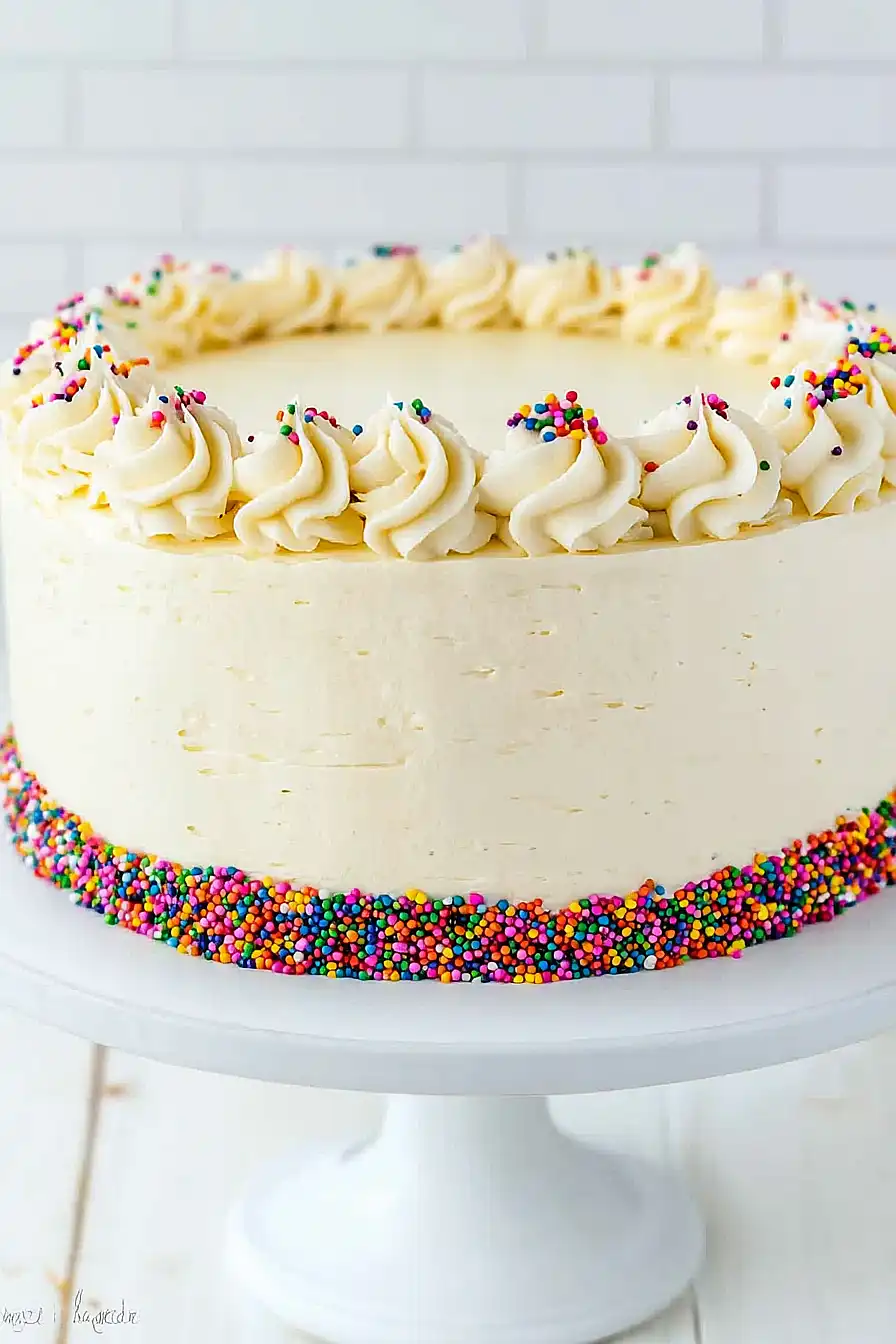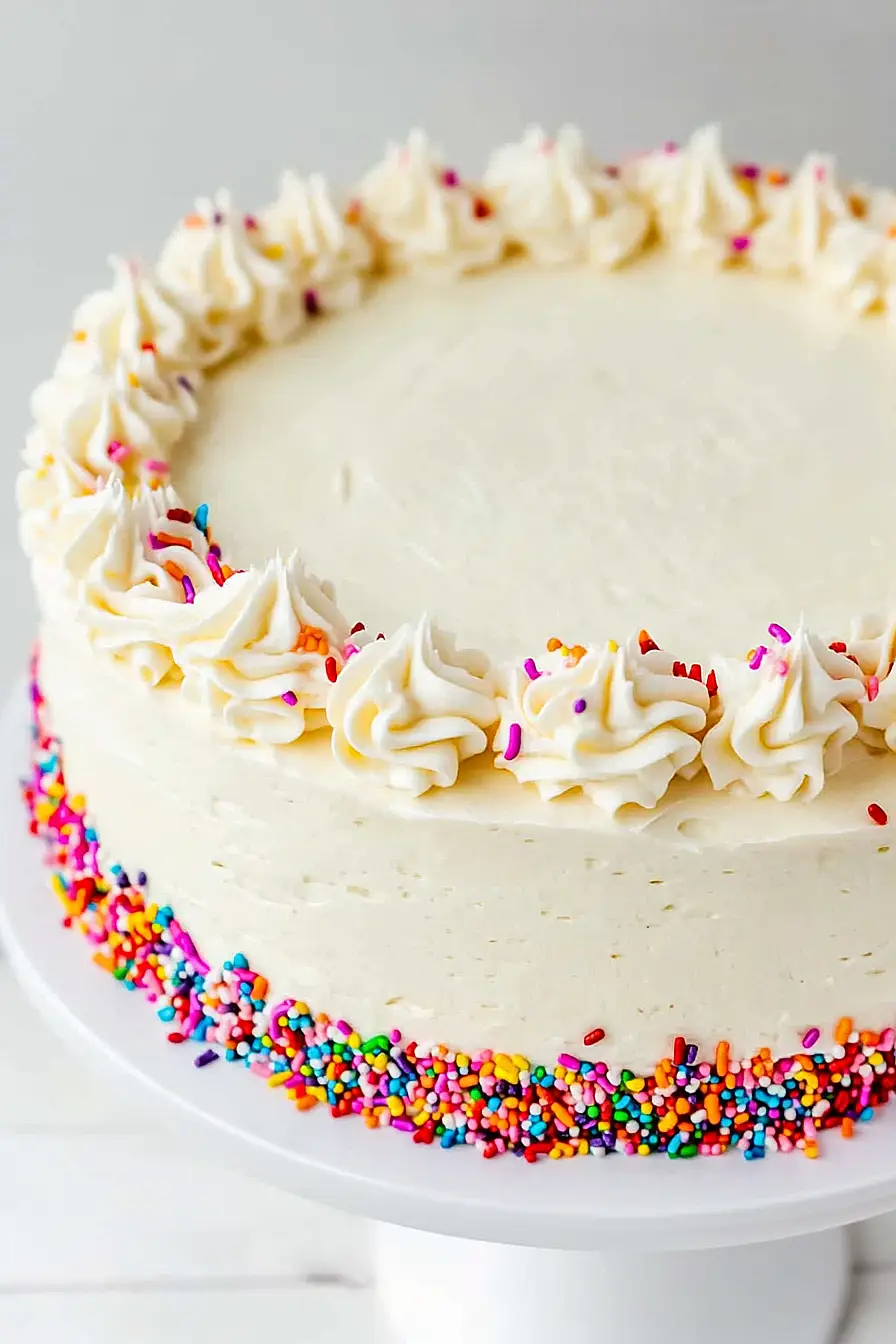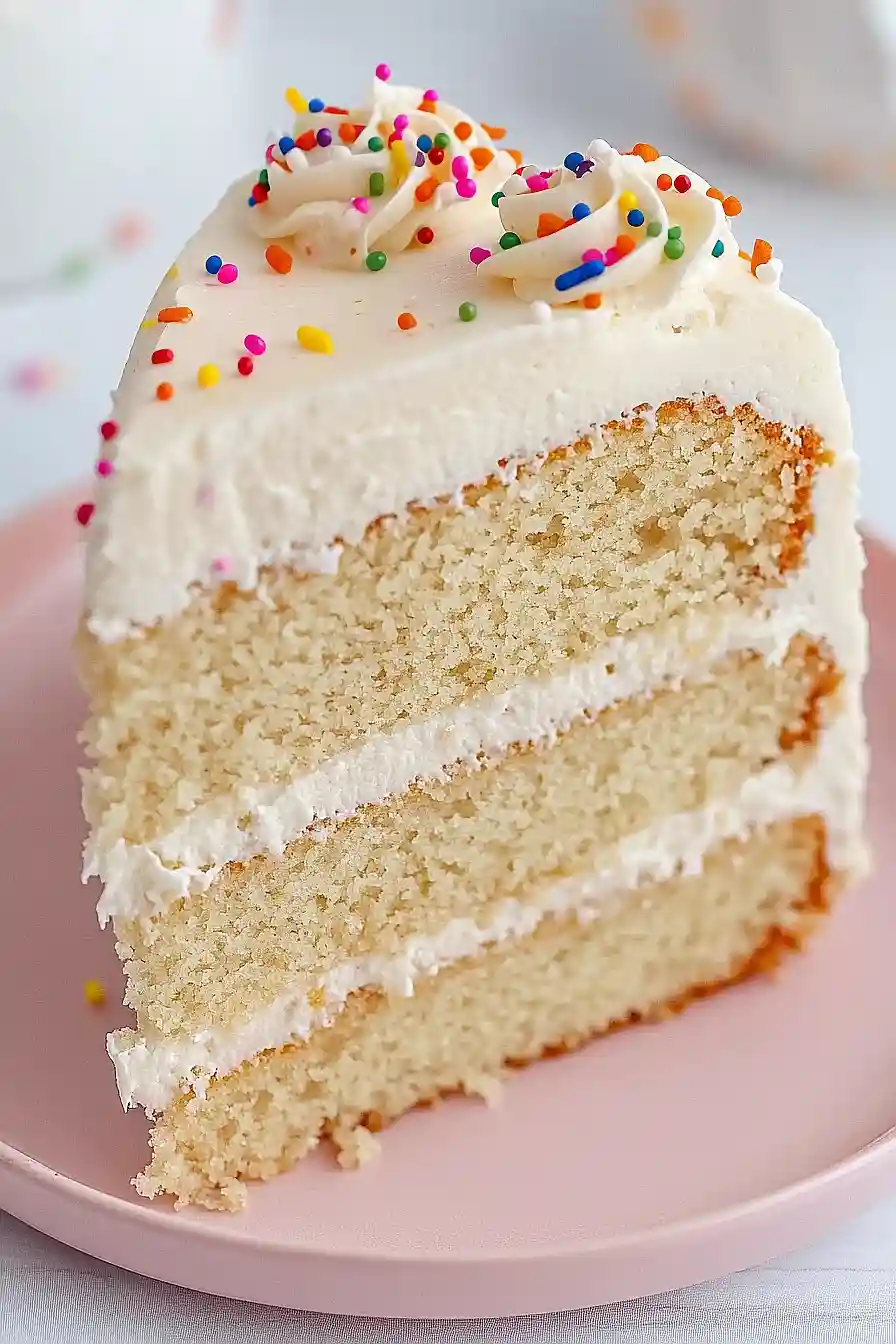Finding a reliable cake recipe that works for everyone can feel like searching for a needle in a haystack, especially when you’re baking for someone with egg allergies or dietary restrictions. Between birthday parties, school events, and family gatherings, having a dependable eggless recipe becomes even more important when you want to make sure no one misses out on enjoying a slice of homemade cake.
That’s where this eggless vanilla cake comes to the rescue: it’s soft and moist, super easy to make, and tastes just as good as traditional vanilla cake – proving that you don’t need eggs to create a dessert that everyone will love.
Why You’ll Love This Vanilla Cake
- Allergy-friendly – Perfect for those with egg allergies or dietary restrictions, this cake proves you don’t need eggs to make a delicious dessert.
- Adaptable recipe – You can easily make this dairy-free by switching to plant-based milk and butter alternatives, making it perfect for various dietary needs.
- Simple ingredients – Made with basic pantry staples you likely already have at home – no special egg replacers or hard-to-find ingredients needed.
- Reliable results – The combination of baking powder and apple cider vinegar ensures a perfectly risen, soft cake every time, even without eggs.
- Quick preparation – This cake comes together in under an hour, making it perfect for last-minute celebrations or weekend baking projects.
What Kind of Flour Should I Use?
For this eggless vanilla cake, regular all-purpose flour is your best friend. While you might be tempted to grab cake flour, stick with all-purpose flour since it has just the right amount of protein to give your cake structure, especially important when baking without eggs. If you’re in a pinch, self-rising flour can work too – just remember to skip the baking powder and salt in the recipe since they’re already included. When measuring your flour, try to avoid packing it into the measuring cup – instead, spoon it in and level it off with a knife for the most accurate measurement. This will help prevent your cake from becoming too dense or dry.
Options for Substitutions
This eggless cake recipe is super adaptable and here are some handy swaps you can try:
- All-purpose flour: You can use self-rising flour – just remember to skip the baking powder and salt if you do. For a gluten-free version, try a 1:1 gluten-free flour blend, but the texture might be slightly different.
- Apple cider vinegar: White vinegar or lemon juice work just as well here – they help create the same reaction with the milk to make a buttermilk substitute.
- Whole milk: Any plant-based milk works great – try almond, soy, or oat milk. Just make sure it’s unsweetened to keep the sugar levels right.
- Butter: For a dairy-free cake, use the same amount of neutral-flavored oil or dairy-free butter. If using oil, reduce the amount to 3/4 cup instead of 1 cup.
- Granulated sugar: You can swap in caster sugar or even coconut sugar, though coconut sugar will make the cake slightly darker and give it a subtle caramel taste.
- Baking powder: This is a crucial ingredient that can’t be substituted as it’s what makes the cake rise without eggs. Make sure it’s fresh for best results.
Watch Out for These Mistakes While Baking
The success of an eggless vanilla cake heavily depends on the proper reaction between the baking powder and apple cider vinegar, so make sure your baking powder is fresh and active – test it by putting a small amount in warm water to see if it fizzes.
Temperature control is crucial here – using cold milk or butter that isn’t properly softened can lead to a dense, uneven cake, so bring all ingredients to room temperature before starting and cream the butter and sugar until light and fluffy (about 3-4 minutes).
Over-mixing the batter once you’ve added the flour is a common mistake that can make your cake tough and rubbery – instead, fold the dry ingredients gently just until combined, and don’t be tempted to keep stirring.
For the best texture, measure your flour correctly by spooning it into the measuring cup and leveling it off with a knife rather than scooping directly from the flour bag, which can pack too much flour into your measurements and result in a dry cake.
What to Serve With Eggless Vanilla Cake?
This simple vanilla cake is super versatile when it comes to pairings! A scoop of your favorite ice cream – whether it’s classic vanilla, chocolate, or strawberry – makes this cake even more special. Fresh berries like strawberries, raspberries, or blueberries add a nice pop of freshness and natural sweetness that works really well with the vanilla flavor. For a cozy touch, try serving each slice with a warm cup of coffee, tea, or hot chocolate – the combo of warm drink and sweet cake is just perfect for any time of day. If you’re feeling extra indulgent, a drizzle of chocolate or caramel sauce over the top takes this cake to the next level.
Storage Instructions
Keep Fresh: This eggless vanilla cake stays moist and yummy when kept at room temperature for up to 2 days. Just pop it in an airtight container or wrap it well with plastic wrap. If you live somewhere humid, it’s better to keep it in the fridge to prevent it from getting too sticky.
Refrigerate: Want to keep your cake longer? Store it in the fridge in an airtight container for up to a week. The butter in the recipe might make it firm up a bit, but don’t worry – that’s totally normal!
Freeze: This cake freezes really well! Cut it into portions, wrap each piece in plastic wrap and aluminum foil, then pop them in a freezer bag. It’ll stay good for up to 3 months. When you’re craving cake, just thaw a piece in the fridge overnight.
Make Ahead: You can bake this cake a day before your special event. Just let it cool completely, wrap it well, and store it at room temperature or in the fridge. If you’re planning to frost it, it’s actually better to work with a completely cooled cake!
| Preparation Time | 20-30 minutes |
| Cooking Time | 20-25 minutes |
| Total Time | 40-55 minutes |
| Level of Difficulty | Medium |
Estimated Nutrition
Estimated nutrition for the whole recipe (without optional ingredients):
- Calories: 4000-4200
- Protein: 40-50 g
- Fat: 300-310 g
- Carbohydrates: 500-520 g
Ingredients
- 4 cups all-purpose flour
- 6 tsp baking powder
- 1 tsp salt
- 2 cups whole milk (dairy or plant-based alternative)
- 2 tbsp apple cider vinegar
- 2 cups white sugar
- 1 cup unsalted butter, softened
- 2 tsp vanilla extract
Step 1: Prepare the Ingredients and Pans
- 1 cup unsalted butter, softened
- 2 cups whole milk (dairy or plant-based alternative)
- Baking spray with flour (for greasing pans)
Start by bringing all your refrigerated ingredients, like butter and milk, to room temperature.
This is crucial for ensuring a smooth batter with the best rise and texture.
Pre-measure all your ingredients and, if possible, use a kitchen scale for maximum precision.
Preheat your oven to 350º F (180º C).
Line three 8-inch (20 cm) round cake pans with parchment paper and lightly grease them with baking spray with flour.
Step 2: Sift and Mix Dry Ingredients
- 4 cups all-purpose flour
- 6 tsp baking powder
- 1 tsp salt
In a large bowl, sift the all-purpose flour and baking powder together.
Add the salt and whisk to combine all the dry ingredients evenly.
Step 3: Combine the Milk and Vinegar
- 2 cups whole milk (dairy or plant-based alternative)
- 2 tbsp apple cider vinegar
In a small bowl, combine the whole milk and apple cider vinegar.
Set this mixture aside to let it slightly sour, mimicking buttermilk.
This step helps add tenderness to the cake crumb.
I find that this buttermilk substitute gives cakes a softer texture.
Step 4: Cream Butter and Sugar, Add Vanilla
- 1 cup unsalted butter, softened (from Step 1)
- 2 cups white sugar
- 2 tsp vanilla extract
In the bowl of a stand mixer or with a hand mixer, beat the softened butter on medium-high speed until creamy, about 3–4 minutes.
Add the sugar and continue beating on high speed for 4 minutes until the mixture is creamed and pale.
Scrape down the sides and bottom of the bowl as needed.
Add the vanilla extract and beat for another minute to combine.
Step 5: Combine All Ingredients to Make the Batter
- Flour mixture from Step 2
- Milk mixture from Step 3
- Butter-sugar-vanilla mixture from Step 4
With the mixer on low, add the dry flour mixture (from Step 2) in three batches to the butter mixture (from Step 4), alternating with the milk mixture (from Step 3).
Begin and end with the flour mixture.
Beat just until combined after each addition, for about 30–45 seconds in total.
Do not overmix, as this can make the cake tough.
I always make sure to scrape the bowl to incorporate all the ingredients evenly.
Step 6: Bake the Cakes
- Cake batter from Step 5
Evenly divide the batter among the prepared cake pans (about 2 1/2 cups per pan).
Bake in the preheated oven for 20–25 minutes, or until a toothpick inserted in the center comes out clean.
Let the cakes cool in their pans on a wire rack for 10 minutes, then remove them from the pans and cool completely on the wire rack.
I like to let my cakes cool right-side up so they keep their surface flat for decorating.
Step 7: Decorate the Cake
Once the cakes are completely cool, decorate them as you like.
Frost with your favorite frosting, such as vanilla buttercream, and add sprinkles if desired.
Stack the layers carefully to create a beautiful cake.
For extra flair, I sometimes use seasonal fruits or edible flowers for decoration.




